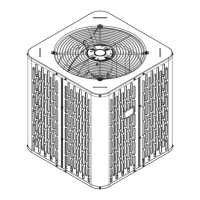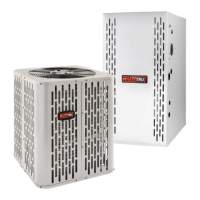Do you have a question about the Trane A4AC3018D and is the answer not in the manual?
General safety warnings, electrical component hazards, and refrigerant handling precautions.
Details unit dimensions and weight specifications for various models.
Specifies maximum total length and vertical change for refrigerant lines.
Provides guidance on optimal placement to ensure reliable operation and airflow.
Offers advice for installations in areas prone to snow and freezing temperatures.
Instructs on checking the unit for damage before installation.
Outlines requirements for installing the unit on a support pad.
Lists sizes for refrigerant lines and service valve connections for each model.
Explains factory charge and emphasizes vapor line insulation requirements.
Guides on determining total line length and vertical change needed for system configuration.
Provides precautions for using existing refrigerant lines during retrofit installations.
Advises on routing lines to prevent noise and vibration transmission through structures.
Details the step-by-step process for brazing refrigerant lines, including preparation.
Describes how to pressurize lines and check for leaks using soapy solution.
Explains how to evacuate the system to specific micron levels for moisture removal.
Provides instructions on how to properly open the gas service valve.
Details the cautious procedure for opening the liquid line service valve.
Lists maximum allowed lengths for low voltage wiring based on wire gauge.
Illustrates wiring connections for various thermostat and system configurations.
Details requirements for the high voltage power supply and compliance with codes.
Recommends disconnect switch and specifies grounding requirements.
Outlines the sequence of steps to safely start up the installed system.
Explains how to measure temperatures to determine the correct charging method.
Details the subcooling method for charging systems in warmer outdoor temperatures.
Describes the weigh-in method for charging systems in colder outdoor temperatures.
Provides a checklist of final inspections and operational tests after installation.
| Cooling Capacity | 1.5 Ton |
|---|---|
| Refrigerant | R-410A |
| Phase | 1 |
| Cooling Capacity (BTU) | 18000 BTU |
| Voltage | 208/230V |
| Indoor Unit Compatibility | Trane Air Handlers |












